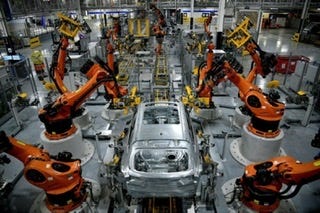Where did all the people go?!
Did car manufacturing look like this in 1960?
Autonomous robots assemble an X model SUV at BMW’s manufacturing facility in Greer, S.C., on Nov. 4, 2019. (Charles Mostoller/Reuters)
The rising cost of Union labour
Any Economist worth his salt knows that business executives seek manufacturing cost reductions in their plants, warehouses and supply chains in order to compete successfully in their markets.
Investments made in automotive manufacturing over the last 60 years have always been made with cost-cutting and quality improvements in mind. A reasonable Return On Investment was always the goal of these investments.
Unions were successful in negotiating higher wages and better employment benefits for plant workers since the 1930s. However, it was always just a matter of time before their wins turned sour. Two negative consequences are worth mentioning.
As the cost of labour rose, automotive executives moved their plants to new locations which offered labour and policy conditions that better served their corporate goals. Plants in Michigan, for example, moved to southern states like Tennessee and Texas where ‘right to work’ employment policies prevailed. These states attracted manufacturers by suppressing union influences on labour costs. Mexico also benefitted enormously for similar reasons.
Automation has replaced much of the human capital costs associated with manufacturing production and assembly lines as well as warehouse operations. Robots do not need wages, benefits, training, sick pay, vacation time or coffee breaks. They can work non-stop 24-7 if need be in order to meet aggressive production schedules.
Union Labour Is Not Alone.
Technology continues to replace human beings in virtually every employment sector (unionized or not) where simple, repetitive tasks and uncomplicated decisions are required. This reality is one on the main reasons why the Universal Basic Income (UBI) is a hot topic in many political circles.
Jobs requiring human creativity are less threatened by advancing technologies. This is also true for jobs that offer care-giving services to people and animals whose health and thriving depend on them. In fact, many other services also remain immune to obsolescence by technology and, in most cases, are enhanced because of it.
It’s worth noting that about 75% of all government employees in Ontario, my home province, belong to a union as a condition of employment backed by legislation. These are not manufacturing jobs and, as such, they are not subject to the two conditions and consequences outlined above.
If the public sector institutions faced competition in the same way as automotive manufacturers, would todays government work places feature the equivalent investments in labour-saving technologies as shown in this pictured BMW plant?
A Race to the Bottom?
Many pro-union advocates claim that unregulated capitalism, and its driving spirit of competition, inevitably leads to the impoverishment of the “working class” and the enrichment of the owners of capital. Is this really true, or are there other forces at play that have increased the gap between “rich and poor”?
Experts in Economics know that there are many factors which determine economic outcomes. The “race to the bottom” claims are nothing more than simplistic rhetoric aimed at stoking the emotions of economic illiterates who lack the training to understand the many complexities that are truly responsible for the “wealth divide”.
Cronyism Plays A Major Part
Corporate lobbyists are paid to influence politicians and government officials so that laws and regulations will be enacted to favour their goals. They negotiate back-room deals that are mutually-rewarding but costly to others. Today’s labyrinth of red tape represents the culmination of these acts of cronyism over many decades.
Crony Capitalism, Crony Socialism and Crony Statism all add incalculably to the “cost of doing business” and the economic perversions that affects us all when paying our tax bills or purchasing products at the retail store.
There is more than enough blame for this corruption to be found in political-motivated government policies, special interest organizations such as labour unions and profit-motivated corporate boards to go around.



